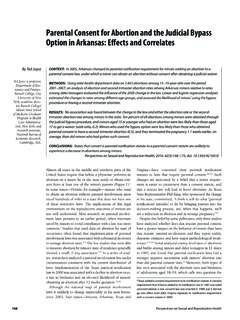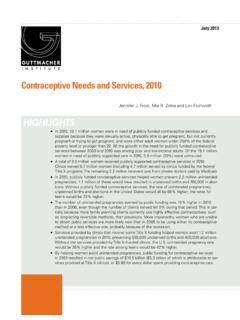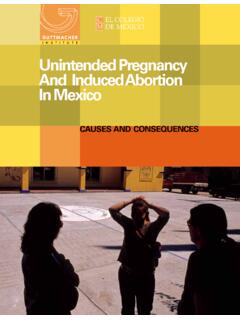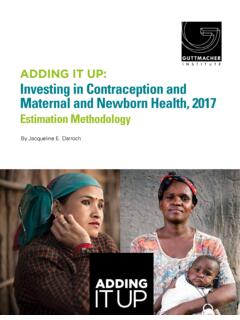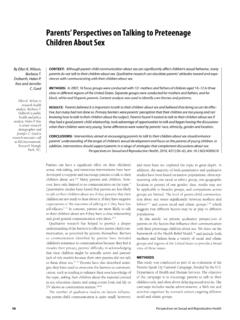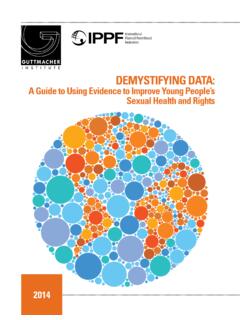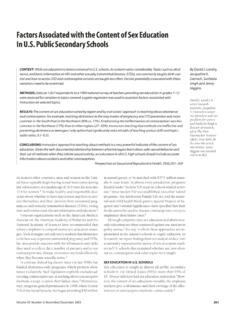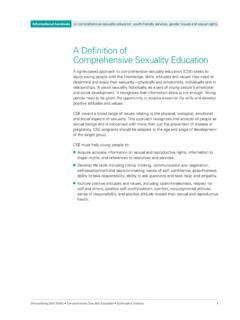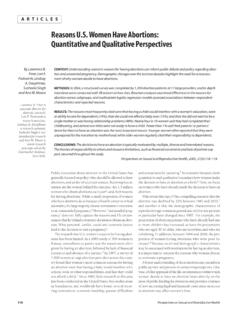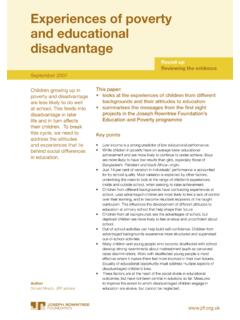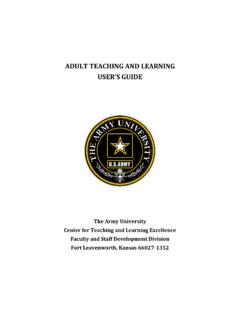Transcription of Reasons U.S. Women Have Abortions: Quantitative and ...
1 110 Perspectives on Sexual and Reproductive HealthPublic discussion about abortion in the United States hasgenerally focused on policy: who should be allowed to haveabortions, and under what circumstances. Receiving less at-tention are the Women behind the statistics the millionwomen who obtain abortions each year1 and their reasonsfor having abortions. While a small proportion of womenwho have abortions do so because of health concerns or fetalanomalies, the large majority choose termination in responseto an unintended , unintended preg-nancy does not fully capture the Reasons and life circum-stances that lie behind a woman s decision to obtain an abor-tion.
2 What personal, familial, social and economic factorslead to the decision to end a pregnancy?The research into Women s Reasons for having abor-tions has been limited. In a 1985 study of 500 Women inKansas, unreadiness to parent was the reason most oftengiven for having an abortion, followed by lack of financialresources and absence of a 1987, a survey of1,900 Women at large abortion providers across the coun-try found that Women s most common Reasons for havingan abortion were that having a baby would interfere withschool, work or other responsibilities, and that they couldnot afford a 1987, little research in this areahas been conducted in the United States.
3 But studies donein Scandinavia and worldwide have found several recur-ring motivations: economic hardship, partner difficultiesand unreadiness for extensive literature (bothquantitative and qualitative) examines how Women makethe decision to have an abortion or a , we focuson Women who have already made the decision to have revisit this topic? One compelling reason is that theabortion rate declined by 22% between 1987 and 2002,7and another is that the demographic characteristics ofreproductive-age Women in general and of abortion patientsin particular have changed since 1987.
4 For example, theproportion of abortion patients who have already had oneor more children has increased, as have the proportionswho are aged 30 or older, who are nonwhite and who arecohabiting. In addition, between 1994 and 2000, the pro-portion of Women having abortions who were poor social and demographic characteristicsmay be associated with motivations for having an abortion,it is important to reassess the Reasons why Women chooseto terminate a better understanding of these motivations can informpublic opinion and prevent or correct misperceptions.
5 Like-wise, a fuller appraisal of the life circumstances within whichwomen decide to have an abortion bears directly on theissue of public funding for abortions and provides evidenceof how increasing legal and financial constraints on accessto abortion may affect Women s Women Have Abortions: Quantitative and Qualitative PerspectivesLawrence B. Finer isassociate director fordomestic research,Lori F. Frohwirth isresearch associate,Lindsay A. Dauphineeis research assistant,Susheela Singh is vicepresident for researchand Ann M.
6 Moore issenior researchassociate all at theGuttmacher Institute,New :Understanding Women s Reasons for having abortions can inform public debate and policy regarding abor-tion and unwanted pregnancy. Demographic changes over the last two decades highlight the need for a reassess-ment of why Women decide to have :In 2004, a structured survey was completed by 1,209 abortion patients at 11 large providers, and in-depthinterviews were conducted with 38 Women at four sites. Bivariate analyses examined differences in the Reasons forabortion across subgroups, and multivariate logistic regression models assessed associations between respondentcharacteristics and reported :The Reasons most frequently cited were that having a child would interfere with a woman s education, workor ability to care for dependents (74%); that she could not afford a baby now (73%); and that she did not want to be asingle mother or was having relationship problems (48%).
7 Nearly four in 10 Women said they had completed theirchildbearing, and almost one-third were not ready to have a child. Fewer than 1% said their parents or partners desire for them to have an abortion was the most important reason. Younger Women often reported that they wereunprepared for the transition to motherhood, while older Women regularly cited their responsibility to :The decision to have an abortion is typically motivated by multiple, diverse and interrelated themes of responsibility to others and resource limitations, such as financial constraints and lack of partner sup-port, recurred throughout the on Sexual and Reproductive Health, 2005, 37(3):110 118By Lawrence , Lori , LindsayA.
8 Dauphinee,Susheela Singhand Ann M. Moore111 Volume 37, Number 3, September 2005 The fielding period ranged from one to six weeks, de-pending on each facility s caseload. We established a min-imum response rate of 50% of all abortion clients seen byeach facility during its sampling period for the data to beconsidered representative of the Women at that facility. Theoverall response rate was 58%, and facility rates ranged from50% to 76%, because some Women declined participationand some staff had minor difficulties adhering to the pro-tocol.
9 Fielding ran from December 2003 until March 2004,and 1,209 abortion patients completed the ComponentWe also conducted in-depth interviews with 38 Women atfour sites. The interview guide included all of the same top-ics as the survey. The selected sites were hospital-based andfreestanding, in different regions of the country and in stateswith differing restrictions on access to and Medicaid re-imbursement for abortion services. The sites were also cho-sen to represent varying city sizes and to capture a crosssection of abortion patients.
10 In three of these facilities, thestructured survey had also been distributed. Staff at thestudy clinics offered all abortion patients a chance to par-ticipate; recruitment was not based on social or demo-graphic of the study team interviewed respondents dur-ing their medical visit, typically before the were informed that the interviews would be record-ed, and they provided verbal consent. The interviews last-ed 30 60 minutes and were anonymous. The qualitativecomponent was limited to fluent English speakers.
